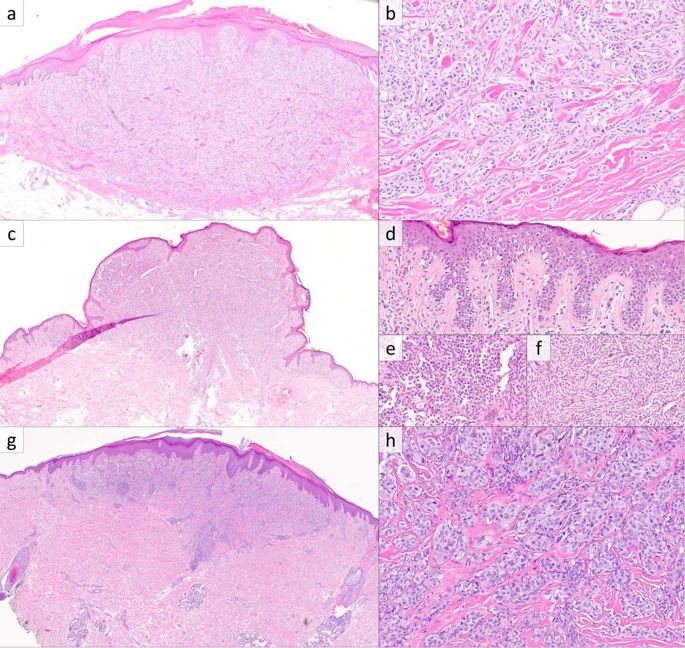当前位置:
X-MOL 学术
›
Modern Pathol.
›
论文详情
Our official English website, www.x-mol.net, welcomes your
feedback! (Note: you will need to create a separate account there.)
Melanomas with activating RAF1 fusions: clinical, histopathologic, and molecular profiles.
Modern Pathology ( IF 7.1 ) Pub Date : 2020-03-02 , DOI: 10.1038/s41379-020-0510-7 Erik A Williams 1 , Nikunj Shah 1 , Meagan Montesion 1 , Radwa Sharaf 1 , Dean C Pavlick 1 , Ethan S Sokol 1 , Brian M Alexander 1 , Jeff M Venstrom 1 , Julia A Elvin 1 , Jeffrey S Ross 1, 2 , Julie Y Tse 1, 3 , Mark C Mochel 4
Modern Pathology ( IF 7.1 ) Pub Date : 2020-03-02 , DOI: 10.1038/s41379-020-0510-7 Erik A Williams 1 , Nikunj Shah 1 , Meagan Montesion 1 , Radwa Sharaf 1 , Dean C Pavlick 1 , Ethan S Sokol 1 , Brian M Alexander 1 , Jeff M Venstrom 1 , Julia A Elvin 1 , Jeffrey S Ross 1, 2 , Julie Y Tse 1, 3 , Mark C Mochel 4
Affiliation

|
A subset of melanomas is characterized by fusions involving genes that encode kinases. Melanomas with RAF1 fusions have been rarely reported, mostly in clinical literature. To investigate this distinctive group of melanomas, we searched for melanomas with activating structural variants in RAF1, utilizing our case archive of clinical samples with comprehensive genomic profiling (CGP) by a hybrid capture-based DNA sequencing platform. Clinical data, pathology reports, and histopathology were reviewed for each case. RAF1 breakpoints, fusion partners, and co-occurring genetic alterations were characterized. From a cohort of 7119 melanomas, 40 cases (0.6%) featured fusions that created activating structural variants in RAF1. Cases with activating RAF1 fusions had median age of 62 years, were 58% male, and consisted of 9 primary tumors and 31 metastases. Thirty-nine cases were cutaneous primary, while one case was mucosal (anal) primary. Primary cutaneous melanomas showed variable architectures, including wedge-shaped and nodular growth patterns. Cytomorphology was predominantly epithelioid, with only one case, a desmoplastic melanoma, consisting predominantly of spindle cells. RAF1 5' rearrangement partners were predominantly intrachromosomal (n = 18), and recurrent partners included MAP4 (n = 3), CTNNA1 (n = 2), LRCH3 (n = 2), GOLGA4 (n = 2), CTDSPL (n = 2), and PRKAR2A (n = 2), all 5' of the region encoding the kinase domain. RAF1 breakpoints occurred in intron 7 (n = 32), intron 9 (n = 4), intron 5 (n = 2), and intron 6 (n = 2). Ninety-eight percent (n = 39) were wild type for BRAF, NRAS, and NF1 genomic alterations (triple wild type). Activating RAF1 fusions were present in 2.1% of triple wild-type melanomas overall (39/1882). In melanomas with activating RAF1 fusions, frequently mutated genes included TERTp (62%), CDKN2A (60%), TP53 (13%), ARID2 (10%), and PTEN (10%). Activating RAF1 fusions characterize a significant subset of triple wild-type melanoma (2.1%) with frequent accompanying mutations in TERTp and CDKN2A. CGP of melanomas may improve tumor classification and inform potential therapeutic options, such as consideration of specific kinase inhibitors.
中文翻译:

具有激活 RAF1 融合的黑色素瘤:临床、组织病理学和分子特征。
黑色素瘤的一个子集的特点是涉及编码激酶的基因融合。具有 RAF1 融合的黑色素瘤很少有报道,主要是在临床文献中。为了研究这一类独特的黑色素瘤,我们通过基于混合捕获的 DNA 测序平台,利用我们的临床样本病例档案和全面的基因组分析 (CGP),搜索了 RAF1 中具有激活结构变异的黑色素瘤。对每个病例的临床数据、病理报告和组织病理学进行了审查。对 RAF1 断点、融合伙伴和同时发生的基因改变进行了表征。在 7119 例黑色素瘤队列中,40 例 (0.6%) 具有在 RAF1 中产生激活结构变异的融合。激活 RAF1 融合的病例中位年龄为 62 岁,其中 58% 为男性,由 9 个原发肿瘤和 31 个转移瘤组成。皮肤原发性39例,粘膜(肛门)原发性1例。原发性皮肤黑色素瘤表现出不同的结构,包括楔形和结节状生长模式。细胞形态学主要为上皮样,只有一例为促纤维增生性黑色素瘤,主要由梭形细胞组成。 RAF1 5' 重排伴侣主要是染色体内 (n = 18),复发伴侣包括 MAP4 (n = 3)、CTNNA1 (n = 2)、LRCH3 (n = 2)、GOLGA4 (n = 2)、CTDSPL (n = 2) 和 PRKAR2A (n = 2),编码激酶结构域的区域的所有 5'。 RAF1 断点发生在内含子 7 (n = 32)、内含子 9 (n = 4)、内含子 5 (n = 2) 和内含子 6 (n = 2) 中。 98% (n = 39) 是 BRAF、NRAS 和 NF1 基因组改变的野生型(三重野生型)。总共 2.1% 的三重野生型黑色素瘤中存在激活的 RAF1 融合 (39/1882)。 在具有激活 RAF1 融合的黑色素瘤中,频繁突变的基因包括 TERTp (62%)、CDKN2A (60%)、TP53 (13%)、ARID2 (10%) 和 PTEN (10%)。激活 RAF1 融合是三重野生型黑色素瘤 (2.1%) 的一个重要子集的特征,其中频繁伴随着 TERTp 和 CDKN2A 突变。黑色素瘤的 CGP 可以改善肿瘤分类并为潜在的治疗选择提供信息,例如考虑特定激酶抑制剂。
更新日期:2020-03-02
中文翻译:

具有激活 RAF1 融合的黑色素瘤:临床、组织病理学和分子特征。
黑色素瘤的一个子集的特点是涉及编码激酶的基因融合。具有 RAF1 融合的黑色素瘤很少有报道,主要是在临床文献中。为了研究这一类独特的黑色素瘤,我们通过基于混合捕获的 DNA 测序平台,利用我们的临床样本病例档案和全面的基因组分析 (CGP),搜索了 RAF1 中具有激活结构变异的黑色素瘤。对每个病例的临床数据、病理报告和组织病理学进行了审查。对 RAF1 断点、融合伙伴和同时发生的基因改变进行了表征。在 7119 例黑色素瘤队列中,40 例 (0.6%) 具有在 RAF1 中产生激活结构变异的融合。激活 RAF1 融合的病例中位年龄为 62 岁,其中 58% 为男性,由 9 个原发肿瘤和 31 个转移瘤组成。皮肤原发性39例,粘膜(肛门)原发性1例。原发性皮肤黑色素瘤表现出不同的结构,包括楔形和结节状生长模式。细胞形态学主要为上皮样,只有一例为促纤维增生性黑色素瘤,主要由梭形细胞组成。 RAF1 5' 重排伴侣主要是染色体内 (n = 18),复发伴侣包括 MAP4 (n = 3)、CTNNA1 (n = 2)、LRCH3 (n = 2)、GOLGA4 (n = 2)、CTDSPL (n = 2) 和 PRKAR2A (n = 2),编码激酶结构域的区域的所有 5'。 RAF1 断点发生在内含子 7 (n = 32)、内含子 9 (n = 4)、内含子 5 (n = 2) 和内含子 6 (n = 2) 中。 98% (n = 39) 是 BRAF、NRAS 和 NF1 基因组改变的野生型(三重野生型)。总共 2.1% 的三重野生型黑色素瘤中存在激活的 RAF1 融合 (39/1882)。 在具有激活 RAF1 融合的黑色素瘤中,频繁突变的基因包括 TERTp (62%)、CDKN2A (60%)、TP53 (13%)、ARID2 (10%) 和 PTEN (10%)。激活 RAF1 融合是三重野生型黑色素瘤 (2.1%) 的一个重要子集的特征,其中频繁伴随着 TERTp 和 CDKN2A 突变。黑色素瘤的 CGP 可以改善肿瘤分类并为潜在的治疗选择提供信息,例如考虑特定激酶抑制剂。









































 京公网安备 11010802027423号
京公网安备 11010802027423号